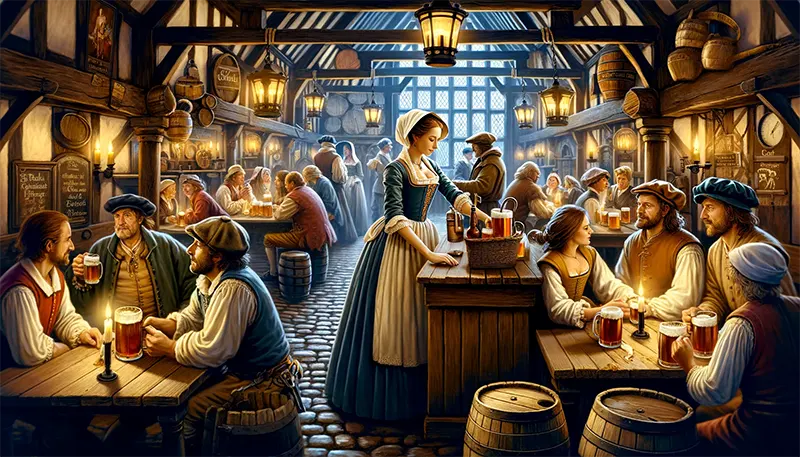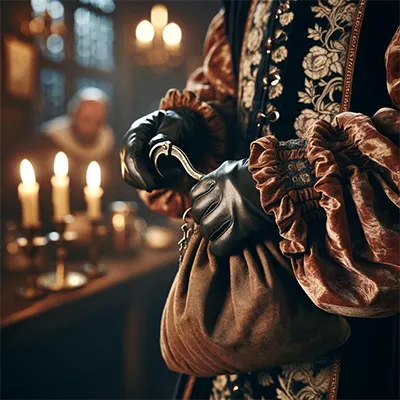Step back in time, and discover ale in Tudor England, where ale was more than just a drink. It was a way of life, a social lubricant, and even a safe alternative to water.

What’s the difference between beer and ale?
Beer is a broad term that refers to alcoholic beverages made from fermented grains. There are different types of beer, but they mainly fall into two categories: ales and lagers.
The main difference between these two comes down to the yeast used for fermentation and the temperature at which they ferment. Yeast is a tiny microorganism that eats up sugars from grains, producing alcohol and carbon dioxide in the process. So ales can be a beer but a bee is not an ale.
Ales are made with a top-fermenting yeast that works best at warmer temperatures, usually between 60-75°F (15-24°C). This type of yeast rises to the top of the brew during fermentation.
Ales are known for their robust and fruity flavours and can be ready to drink in a shorter amount of time. On the other hand, when people say “beer” in contrast to “ale,” they often mean lagers, which use a bottom-fermenting yeast that prefers cooler conditions, around 35-50°F (2-10°C).
Lagers ferment more slowly and have a cleaner and crisper taste compared to ales. So, the difference between beer and ale mainly hinges on the fermentation process and the yeast used, leading to different flavours and characteristics in the final drink.
So what about Ale in Tudor England?
Ale in Tudor England was more than just something to drink. It was an important part of daily life, a way for people to socialise, and was a safer choice than water. But, ale is still alcoholic, and the authorities were worried about the huge amount of alcohol people were drinking and the problems it caused.
Ale was a very popular drink in Tudor England, and people of all ages, including children, enjoyed it. The water was often dirty and unsafe to drink, so ale was a better choice because it was boiled during brewing. People in Coventry in 1520 drank as much as 17 pints of ale a week! People in the Tudor era thought it was safer to drink ale than water, and some even had ale for breakfast. They weren’t wrong. A health writer from the Tudor period, Andrew Boorde, called ale a “natural drink” whereas he described water as “not wholesome”.
Ale was usually made at home, and the job of brewing often fell to the woman, lady of the house, who was called an “alewife.” She mixed malted barley with water and yeast and left it to ferment. Hops, was not widely used until later in the Tudor period. The quality of the ale could be very different from one brew to another, and sometimes alewives added strange ingredients to flavour their brews. In 1521, a poet named John Skelton wrote about an alewife named Elynour Rummynge who used hen’s dung to flavour her ale! Yum.
Ale in Tudor England was so important that it was sometimes used as payment. Workers, such as farm labourers and servants, often received a daily ration of ale as part of their wages. Even the soldiers in the Tudor army were given ale to drink as part of their rations.
Ale also played an important role in the social lives of the Tudor people. Alehouses were places where people could gather to chat, relax, and catch up on local news. Unfortunately, these places were often called “nurseries of naughtiness” because of the trouble caused by people who drank too much. By 1577, there was one alehouse for every 200 people. To be fair where I grew up there were two pubs in our village so that’s not that hard to imagine. And, no, I wasn’t around in Tudor times!

Crime was a common problem in alehouses. People often stole from each other, and some alehouses even had thieves who would use a line to hook people’s purses and other belongings.
Gambling was also rife, with people playing games like dice, cards, marbles, shove-groat, and skittles for money. Some people even cheated by using loaded dice to trick others.
Ale in Tudor England was also enjoyed by more refined folk
Despite the problems caused by ale, many people enjoyed it, including Queen Elizabeth I and her court. In 1593, her court drank 600,000 gallons of beer! The famous playwright William Shakespeare also liked to visit taverns and inns, and some of his plays were even performed in inn yards. One of his favourite places in London, The George, is still there today.
In conclusion, ale was a big part of life in Tudor England. It was a source of nutrition, a safer alternative to water, a way to pay workers, and a place for people to socialize. However, the large amount of alcohol people drank and the problems it caused were serious concerns for the authorities. Today, ale gives us a unique look into the daily lives and social customs of the Tudor people.
More Information About Ale in Tudor England
Ye Olde Good Inn Guide by James Moore (History Press), £9.99
Life in Tudor London: History Extra

